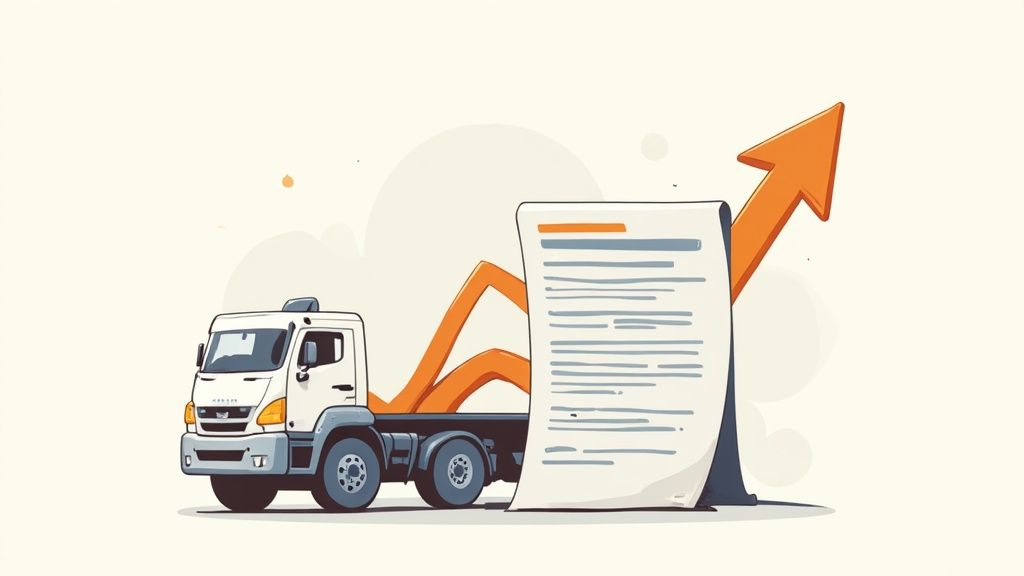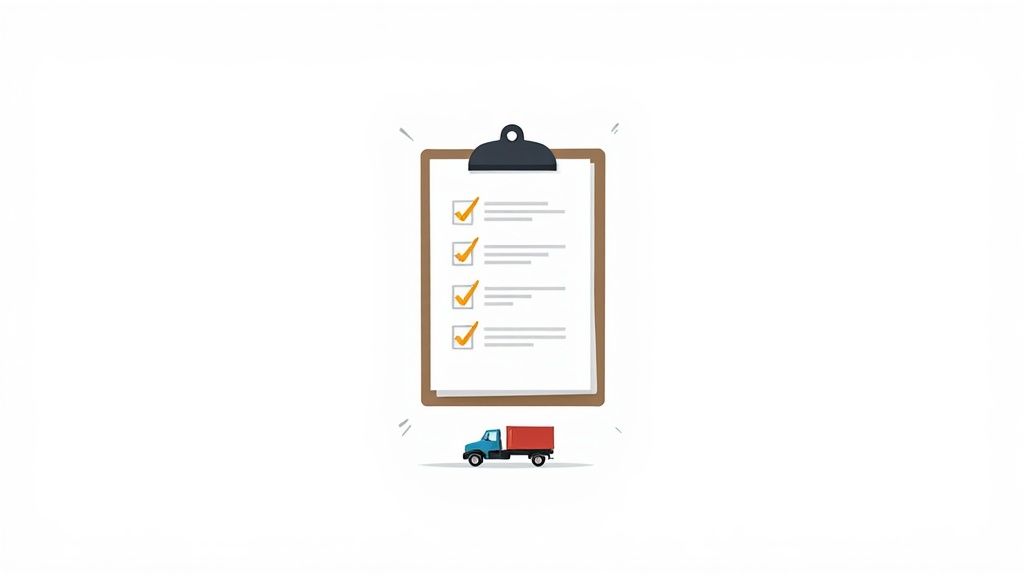The Hidden Cost of Disorganized Fleet Documentation

Disorganized fleet documentation isn’t just a minor inconvenience. It can significantly drain resources, impacting everything from productivity and driver satisfaction to compliance and overall profitability. Imagine trying to build a house with mismatched tools and no blueprints. The process will be slow, expensive, and the end result likely won’t be satisfactory. This analogy holds true for fleet operations struggling with outdated document management.
The True Cost of Paper and Spreadsheets
Many fleets still rely on paper-based systems or a collection of spreadsheets. This creates a breeding ground for errors, misplaced documents, and wasted time. Retrieving important information becomes a tedious chore, and sharing that data across departments is a logistical nightmare. For instance, if a maintenance technician needs a vehicle’s service history, they may have to search through stacks of paper or numerous spreadsheets. This lost time directly translates to lost revenue.
The Compliance Conundrum
Regulations for fleet operations are constantly changing, requiring increasingly accurate and accessible documentation. Next-generation fleet document management technologies often offer automated compliance checks. However, with disorganized systems, it’s almost impossible to stay on top of these evolving requirements. This can lead to significant fines, legal problems, and damage to a company’s reputation. Furthermore, demonstrating compliance during audits becomes a complicated and stressful ordeal.
The Impact on Productivity and Efficiency
Consider a fleet manager who spends hours each week manually inputting data, tracking down paperwork, and seeking approvals. These administrative tasks prevent them from focusing on strategic activities that could actually improve fleet performance. A 2025 State of Fleet Management report from Fleetio highlights these challenges, revealing the surprisingly high cost of inefficient document management. The study found that 87% of fleet managers oversee maintenance compliance, a task heavily reliant on efficient documentation. While 68% use maintenance software, over half struggle with managing multiple platforms. This results in fragmented data and disrupted workflows.
Fleet managers dedicate over 4 hours per week to administrative duties, with 18% spending over 8 hours – a full workday – on manual data entry. This fragmented approach contributes to the 30% of fleets reporting compliance rates below 75%. This clearly shows how outdated documentation practices hinder productivity and contribute to operational inefficiencies. The increasing complexity of fleet operations, combined with strict regulatory demands and intricate maintenance schedules, makes streamlined fleet document management essential. Investing in a modern, centralized system can significantly reduce administrative overhead, freeing up time and resources for more strategic initiatives.
Transforming Documentation From Burden To Business Asset

Effective fleet document management is more than just staying organized. It’s about turning a potential business liability into a valuable asset. Leading fleet operations use their documentation to gain a competitive edge. They achieve significant cost reductions and operational improvements. This shift in perspective is crucial for long-term success.
From Cost Center To Profit Driver
Think of your fleet’s documentation as a well-oiled machine. It should smoothly facilitate every aspect of your operation. Instead of hindering productivity, it actively contributes to profitability. Fleet document management, when streamlined, reduces operating costs.
For example, some organizations report 15-30% reductions in operating expenses. This is achieved by implementing efficient document management systems. This efficiency translates into direct financial gains.
The Downstream Benefits Of Effective Documentation
The impact of well-maintained documentation goes beyond simple organization. It creates a ripple effect of positive outcomes. These impact the entire fleet operation.
Reduced Insurance Premiums: Organized, readily available documentation can often lead to lower insurance premiums. It demonstrates a commitment to safety and risk management.
Faster Vehicle Turnaround Times: Quick access to maintenance records and other documents minimizes vehicle downtime. This keeps vehicles on the road and generating revenue.
Improved Driver Satisfaction: Easy document access and streamlined reporting processes improve driver satisfaction. It also reduces frustration.
These seemingly small improvements contribute to a more efficient and profitable operation.
Measurable Impacts On Key Metrics
The benefits of integrated documentation systems can be measured. Improvements in several key performance indicators (KPIs) demonstrate their value.
Increased Compliance Rates: Centralized document storage and automated alerts ensure regulatory compliance.
Reduced Liability Exposure: Comprehensive documentation offers protection during accidents or audits.
Improved Operational Visibility: Real-time access to data allows for informed decisions and proactive problem-solving.
Let’s take a closer look at how these improvements translate into tangible benefits. The following table compares key operational metrics before and after implementing a streamlined document management system.
Benefits of Effective Fleet Document Management
| Operational Metric | Traditional Approach | With Streamlined Document Management | Improvement Percentage |
|---|---|---|---|
| Operating Expenses | $100,000 | $75,000 | 25% |
| Vehicle Downtime (Days/Year) | 10 | 5 | 50% |
| Insurance Premiums | $20,000 | $18,000 | 10% |
| Compliance Violations | 5 | 1 | 80% |
As you can see, streamlining document management leads to substantial improvements across various metrics. From reducing costs to minimizing downtime and improving compliance, the benefits are clear.
By adopting a platform like Superdocu, fleets can create custom workflows. They can utilize pre-built templates and establish branded portals for secure document collection. This simplifies tasks like managing driver qualifications, vehicle registrations, and maintenance records. These are all vital for efficient fleet document management. These enhancements allow fleet managers to move beyond minimum requirements. They can focus on using their documentation as a strategic asset. This transition from reactive document management to proactive strategic utilization is key to achieving operational excellence.
Breaking Free From Paper: The Digital Documentation Shift

Disorganized documentation creates headaches for any business. But thankfully, fleet operations are moving towards digital solutions to manage their documents more efficiently. This shift provides a major opportunity to boost efficiency, cut costs, and improve compliance. It’s like switching from a rotary phone to a smartphone: the basic function remains, but the potential is far greater.
The Power of Cloud-Based Solutions
Cloud-based fleet document management systems allow access to important information from anywhere with an internet connection. This eliminates physical file cabinets and the risk of losing documents. For instance, a driver involved in an accident can instantly access insurance details and other crucial documents via a mobile app, simplifying the incident reporting process. Cloud storage also adds better security, keeping sensitive data safe.
Mobile Applications: Empowering Drivers in Real Time
Mobile apps are changing the role of drivers in documentation. Drivers can now submit documentation immediately, reducing delays and increasing accuracy. Imagine a driver doing a pre-trip inspection. With a mobile app, they can document problems, add photos, and submit the report electronically, saving time and ensuring quick communication with maintenance.
Automation: Streamlining Workflows and Reducing Errors
Automated workflows remove manual processing, saving time and resources. This automation reduces human error and ensures consistent compliance with procedures. For example, automated reminders for document renewals can prevent costly expirations. This allows fleet managers to focus on important strategic tasks, not administrative duties. The growth of the global fleet management market shows this need for digital solutions. Valued at USD 23.4 billion in 2024, it’s projected to reach USD 97.6 billion by 2034, with a 16% CAGR. This growth is fueled by industries like e-commerce, which require detailed documentation and real-time updates. Find more detailed statistics here.
OCR: Transforming Physical Documents into Searchable Data
Optical Character Recognition (OCR) transforms paper documents into searchable digital data. This removes manual data entry and makes it easier to find specific information. Searching for a keyword in a stack of papers can be a nightmare. OCR makes this search instant.
Integration: Connecting Systems for a Holistic View
Integration links fleet document management with other essential systems, creating a central hub for all fleet information. Integrating with maintenance systems, driver management platforms, and compliance tools provides a complete picture of fleet operations. This helps with better decision-making. This interconnectedness improves communication and keeps all departments up-to-date. These advancements help fleet operations embrace a more efficient and strategic way to manage documents. By using these digital solutions, fleet managers can move beyond simple document management and use it to achieve business goals. A platform like Superdocu can help with this change, providing tools to customize workflows, automate processes, and ensure secure document gathering.
Mastering the Documentation Ecosystem Every Fleet Needs

Switching from paper to digital document management is a big step for any fleet. But truly effective fleet management involves more than just going digital. It requires a deep understanding of how all your documents connect and work together. This means building a documentation ecosystem that supports every aspect of your fleet’s operation. This section will guide you through the essential parts of this ecosystem and how they work together to create a solid foundation for your fleet.
Categorizing Your Fleet’s Essential Documents
The first step to mastering your fleet’s documentation is categorization. This makes finding and managing documents much easier. Think of it like organizing a toolbox. You wouldn’t just toss all your tools in a pile; you’d group them by their function. The same logic applies to your fleet documents.
Vehicle Documentation: This includes titles, registrations, insurance policies, inspection reports, and any other document specific to each vehicle.
Driver Records: This category covers driver’s licenses, medical certifications, training records, hours-of-service logs, and any other documents related to your drivers.
Maintenance Records: These documents track preventive maintenance schedules, repair histories, parts replacements, and warranties for each vehicle.
Compliance Documentation: This includes all documents needed to meet regulatory requirements, such as DOT regulations, environmental certifications, and other industry-specific rules.
Operational Records: This category encompasses fuel usage logs, incident reports, vehicle assignments, and other records related to daily fleet operations. Using a digital planner can help you stay organized.
Best Practices for Digital Storage and Management
After categorizing your documents, the next step is to implement effective digital storage and management practices. This goes beyond simply scanning paper documents and saving them to a server. It requires a more strategic approach.
Digital Storage Solutions: Choose a secure, cloud-based platform with easy access and strong search capabilities. This allows you to quickly retrieve documents from anywhere.
Retention Periods: Set clear retention policies for each document category. This not only ensures compliance but also helps you avoid storing outdated information. Learn more about document collection best practices.
Access Controls: Put strict access controls in place. This ensures that only authorized personnel can view and edit sensitive documents, protecting confidential information and ensuring data integrity.
Audit Preparation: Set up your document management system with audits in mind. This means maintaining clear audit trails, ensuring documents are readily accessible, and being prepared for regulatory inspections.
To help you manage your fleet documentation, use the checklist below.
To make this easier, we’ve compiled a handy checklist. The following table summarizes key documents, their purpose, how long you need to keep them, and tips for managing them effectively.
Critical Fleet Documentation Checklist
This table outlines essential documents for fleet operations, their purpose, retention requirements, and best management practices.
| Document Type | Purpose | Required Retention Period | Management Best Practice | Risk of Non-Compliance |
|---|---|---|---|---|
| Vehicle Registrations | Proof of legal vehicle operation | Varies by jurisdiction | Store digitally and maintain physical copies | Fines, vehicle impoundment |
| Driver’s Licenses | Verification of driver qualifications | While driver is employed | Secure digital copies; verify regularly | Fines, insurance issues |
| Maintenance Records | Track vehicle maintenance history | Varies by regulation and company policy | Use a centralized system for easy access | Increased breakdowns, safety risks |
| Inspection Reports | Ensure vehicle safety and compliance | As required by law | Integrate with maintenance records | Fines, out-of-service violations |
| Insurance Policies | Proof of coverage in case of accidents | Duration of policy + statute of limitations | Store securely and review regularly | Legal and financial liability |
This checklist provides a starting point for organizing your fleet’s essential documents. By using this table as a guide, you can begin to build a robust document management system.
By implementing these best practices, you can transform your fleet’s documentation from a potential burden into a valuable resource. This proactive approach not only reduces risk but also sets your fleet up for increased efficiency and profitability. You’ll be able to streamline your operations and make better decisions.
Building Your Fleet Document Management Roadmap
Implementing a robust fleet document management system isn’t just about purchasing software. It’s about developing a well-defined roadmap. This involves careful planning, understanding your current needs, and strategizing for long-term success. Think of it like planning a road trip: you wouldn’t just hop in the car and drive. You’d map your route, identify stops, and pack accordingly. The same applies to fleet document management.
Assessing Your Current Documentation Landscape
The first step is assessing your current situation. Where are your documents stored? Are they easy to access? Do you have a system for tracking and retrieving information? Identify existing pain points and shortcomings. This assessment forms the foundation of your roadmap. Are drivers wasting time searching for documents? Is your staff burdened by manual data entry? Pinpointing these challenges helps prioritize improvements.
Identifying Pain Points and Compliance Gaps
Beyond organization, identify compliance gaps. Are you meeting regulatory requirements? Are documents ready for audits? Unaddressed compliance risks can lead to fines and legal problems. Analyze how documentation impacts efficiency. Are slow retrieval processes delaying maintenance or vehicle turnaround times? Understanding these bottlenecks is crucial for justifying improvements. Read also: How to master document workflow automation.
Building the Business Case for Improvement
Once you’ve identified weaknesses and risks, build a case for a new fleet document management solution. Quantify the costs of inefficiencies, such as lost productivity, compliance fines, and liability. This data-driven approach demonstrates the return on investment (ROI) and secures stakeholder buy-in. The fleet management software market highlights the increasing importance of documentation. Between 2024 and 2025, the market is projected to grow from $24.04 billion to $28.24 billion, driven by data demands from autonomous vehicles, real-time monitoring, and predictive maintenance.
Selecting and Implementing the Right Solution
Choosing the right solution is crucial. Consider your operational scale, complexity, and specific needs. Does your fleet operate across multiple regions? Do you need mobile access? Evaluating these factors helps select a fitting system. Focus on seamless data migration and system configuration. A phased approach, starting with a pilot group, can minimize disruption and ensure a smooth transition.
Driving User Adoption and Ensuring Long-Term Success
Implementation is only half the battle. Driving user adoption is equally important. Provide thorough training to all staff, from drivers and maintenance to administrative personnel. Address concerns and highlight the system’s benefits for each role. Ongoing support and feedback mechanisms ensure long-term success and maximize your investment. Effective documentation is a continuous journey. Regular reviews and adjustments will ensure it meets your evolving needs and contributes to a safer, more efficient, and profitable fleet.
Next-Generation Fleet Document Management Technologies
The future of fleet document management is already transforming how businesses operate. Early adopters of new technologies are seeing real benefits in how they create, manage, and use their fleet documentation. These advancements signal a shift where documentation becomes a source of efficiency and valuable insights.
The Rise of AI and Machine Learning
Artificial intelligence (AI) and machine learning (ML) are automating key document management tasks. They automate document classification and validation, significantly reducing processing time and eliminating manual data entry errors. For example, AI can automatically categorize documents like invoices or maintenance reports, freeing up administrative staff. Some systems boast processing time reductions of up to 80%, allowing staff to focus on more strategic activities.
The Power of IoT Sensors
Internet of Things (IoT) sensors in vehicles generate real-time documentation, capturing essential data without human intervention. These sensors automatically gather information on maintenance needs, driving behaviors, and operational metrics. This constant flow of information provides valuable insights into fleet performance and helps predict potential problems. For example, a sensor detecting unusual vibrations can trigger a maintenance alert, preventing a breakdown. Learn more about effective document management workflows in our article, How to master document management workflow.
Blockchain: Creating Tamper-Proof Records
Blockchain technology creates secure, tamper-proof documentation trails. This is critical for accident investigations and compliance checks. Every transaction is recorded securely and chronologically, ensuring data integrity and transparency. This verifiable record protects your company in disputes or audits, adding an extra layer of security and trust to your documentation.
Predictive Analytics: Anticipating Documentation Needs
Predictive analytics uses historical data to forecast future documentation requirements, letting fleet managers proactively address issues. Imagine a system predicting when vehicle registrations are about to expire and automatically generating renewal reminders. This proactive approach minimizes disruptions and ensures continuous compliance.
Mobile Solutions: Empowering Drivers
Mobile solutions involve drivers directly in documentation. Drivers can instantly submit reports, capture images of damage, and access important documents on the go. This reduces delays, improves accuracy, and enhances communication between drivers and management. Empowered drivers become key contributors to efficient documentation.
These next-generation technologies are reshaping fleet document management. By adopting these advancements, fleet operators can improve efficiency and compliance, gaining valuable operational insights for better decision-making and a competitive edge.
Ready to transform your fleet’s document management? Explore Superdocu today! Superdocu’s cloud-based platform streamlines and automates document collection, simplifying fleet information management.
